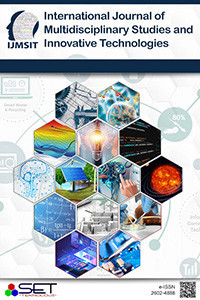AMİDOKSİME-POLİMER AĞYAPILAR İLE BAKIR(II) İYONU ADSORPSİYONU
Bu çalışmada polietilen glikol (PEG 35000MA)’ün akrilonitril içerisindeki çözeltisinin gama ışınları ile 14 ve 60kGy’e ışınlanması sonucu elde edilen IPN (İçiçe-geçmiş Polimer Ağyapı-Interpenetrating Polymer Network)’un hidroksilamin ile amidoksimleştirilmesi sonucu elde edilen amidoksime-polimer ağyapı (amidoksime-IPN) adsorban olarak sulu ortamdan bakır(II) iyonu adsorpsiyonu için denenmiştir. Amidoksimleştirilmiş IPN ile gerçekleştirilen bakır(II) iyonu adsorpsiyonuna pH (2-10) etkisi kesikli sistemde 25°C de incelenmiş, optimum pH değeri 8 olarak bulunmuştur. Atık su pH’ı olan pH=6 ve deniz suyu pH’ı olan pH=8 için yapılan adsorpsiyon çalışmaları sonucunda elde edilen denel izotermlerin, Langmuir ve Freundlich izotermlerine uyumu incelenmiştir. Bakır(II) iyonu derişimi UV-VIS spektrofotometresi ile IPN’in yapı analizleri ise FTIR spektrofotometresi ile saptanmıştır. Karıştırmalı-kesikli sistemde 25°C’de ve pH=8’de, her iki doza ışınlanmış IPN için de 800 mgCu/gIPN‘ın üzerinde adsorpsiyon değerlerine ulaşılmıştır. Sonuç olarak amidoksime-IPN’lerin, 25°C’de pH>6’da bakır(II) iyonlarının sulu ortamdan uzaklaştırılması ve geri kazanımı için verimli bir adsorban olarak kullanılabileceği görülmüştür.
Anahtar Kelimeler:
IPN, amidoksimleştirme, bakır, adsorpsiyon
AMIDOXIME-POLYMER NETWORKS FOR COPPER (II) ION ADSORPTION
In this study, IPN (Interpenetrating Polymer Network) was obtained by irradiating the solution of polyethylene glycol (PEG 35000MA) in acrylonitrile with gamma rays to 14 and 60kGy doses. The amidoxime-polymer network (amidoxime-IPN) obtained by amidoximization of IPN with hydroxylamine was tested for adsorption of copper (II) ions from aqueous media. The effect of pH (2-10) on copper (II) ion adsorption performed with amidoxime-IPN was investigated in the batch system at 25 °C and optimum pH value was found to be 8. The compatibility of the experimental isotherms obtained from the adsorption studies for the wastewater pH=6 and the seawater pH=8 to Langmuir and Freundlich isotherms were investigated. UV-VIS spectrophotometer was used for copper (II) concentration and the structure analysis of IPN was determined by FTIR spectrophotometer. Adsorption values above 800 mgCu/gIPN were reached for both doses irradiated IPN at 25 °C and pH = 8 in the mixed-batch system. As a result, amidoxime-IPNs can be used as an efficient adsorbent for the removal and recovery of copper (II) ions at pH> 6 at 25 °C.
Keywords:
IPN, amidoximation, copper, adsorption,
___
- [1]. Ögenler, O., Okuyaz, S., “Türkiye’de Suyun Durumu Hakkında Kısa Bir Değerlendirme”, Lokman Hekim Dergisi, 2017;7(3):178-186
- [2]. Al-Asheh, S., Banat, F., Mohai, F., “Sorption of Cu and Ni by Spent Animal Bones”, Chemosphere, 1999;l39(12):2087-2096.
- [3]. Ali, H.A., Ribhi, E., “Removal of Lead and Nickel Ions Using Zeolite Tuff.”, J. Chem. Tech. Biotech., 1997;69:27-34.
- [4]. Ahalya, N., Ramachandra, T.V., Kanamadi, R.D., “Biosorption of Heavy Metals”, Res. J Chem. Environ., 2003;7(4):71-79.
- [5]. Ricou,P., Leayer, I. ve Leclairec, P., “Influence of pH on Removal of Heavy Metallic Cations by Fly-Ash in Aqueous Solution”, Env. Tech., 1998;19:1005-1016.
- [6]. Villaescusa, I., Martinez, M., Miralles, N., “Heavy Metal Uptake from Aqueous Solutions by Cork and Yohimbe Bark Wastes”, J.Che. Tech. Biotech., 2000;75:812-816.
- [7]. Astheimer, L., Schenk, H.J., Witte, E.G and Schwochau, K., “Development of sorbers for the recovery of uranium from seawater. 2. The accumulation of uranium from seawater by resins containing amidoxime and imidoxime functional groups”, Sep. Sci. Technol., 1983;18:307-339.
- [8]. Egawa, H., Nanaka, T., Nakayama, M., “Influence of Crosslinking and Porosity on the Uranium Adsorption of Macroreticular Chelating Resin Containing Amidoxime Groups”, J.Macromolecular Sci. Chem., 1988; 25(10-11):1407-1425.
- [9]. Schenk, H.J., Astheimer, L., Witte, E.G and Schwochau, K., “Development of sorbers for the recovery of uranium from seawater. 1. Assessment of key parameters and screening studies of sorber materials”, Sep. Sci. Technol., 1982;17:1293-1308.
- [10]. Coutinho, F.M.B., Rezende, S.M., Barbosa, C.C.R., “Influence of the morphological structure of macroreticular amidoxime resins on their complexation capacity”, Reactive & Functional Polymers, 2001;49:235-248.
- [11]. Güler, H., Şahiner, N., Ayçık, G. A., Güven, O., “Development of Novel Adsorbent Metals For Recovery and Enrichment or Uranium From Aqueous Media”, Journal of Applied Polymer Science, 1997;66:2475-2480.
- [12]. Baybaş, D., Güler, R., Güler, H., Ayçık G.A., “Amidoksimleştirilmiş Ağ Yapılı Bir Polimerin (IPN) 228Ac3+, 212Pb2+, 212Bi3+, 208Tl+ ve UO22+ İçin Adsorban Özelliklerinin İncelenmesi” C.Ü. Fen-Edebiyat Fakültesi Fen Bilimleri Dergisi, 2010; 31(1):43-54
- [13]. Baybaş, D. "Amidoksimleştirilmiş Yarı-IPN ile Sulu Çözeltiden Pb2+ Giderimi". Dokuz Eylül Üniversitesi Mühendislik Fakültesi Fen ve Mühendislik Dergisi, 2018; 20: 776-796
- [14]. Wiechert, A.I., Liao, W., Hong, E.K., Halbert, C.E., Yiacoumi, S., Saito, T., Tsouris, C., "Influence of hydrophilic groups and metal-ion adsorption on polymer-chain conformation of amidoxime-based uranium adsorbents", Journal of Colloid and Interface Science, 2018;524:399-408
- [15]. Wang, J., Liu, F., “Enhanced and selective adsorption of heavy metal ions on ion-imprinted simultaneous interpenetrating network hydrogels”, Designed Monomers and Polymers, 2014;17: 19-25.
- [16]. Li, J., Xu, Z., Wu, W., Jing, Y., Dai, H., Fang, G.,. “Nanocellulose/Poly(2-(dimethyl amino)ethyl methacrylate) Interpenetrating Polymer Network Hydrogels for Removal of Pb(II) and Cu(II) Ions”, Colloids and Surfaces A: Physicochemical and Engineering Aspects., 2018;538:474-480
- [17]. Wang, J., Ding, L., Wei, J., Liu F., “Adsorption of copper ions by ion-imprinted simultaneous interpenetrating network hydrogel: Thermodynamics, morphology and mechanism” Applied Surface Science, 2014;305:412-418
- ISSN: 2602-4888
- Yayın Aralığı: Yılda 2 Sayı
- Başlangıç: 2017
- Yayıncı: SET Teknoloji
Sayıdaki Diğer Makaleler
RESİM YAPIDA VERİTABANI UYGULAMASI
Ebubekir YAŞAR, Turgut ÖZSEVEN
UNITY 3D Oyun Yapma Simulatörü ile 3D Oyun Tasarımı
Serebral Palsili Çocuklar için Giyilebilir Robotik Sistem Tasarımı ve Simülasyonu
Hayriye ALTURAL, Salih ÖZKAN, Gizem YILMAZ
İbrahim Erem ŞAHİN, Kadir Burhan KARACAN
Water Quality of Sultanköy Dam Lake (Ipsala / Edirne): A Preliminary Assessment Study
Sanayi 4.0 Kapsamında İşletmeler Açısından Büyük Veri
Özgür ÇARK, İlker YILDIZ, Alper Talha KARADENİZ
Ebru AYDINDAĞ BAYRAK, Pınar KIRCI, Tolga ENSARİ
